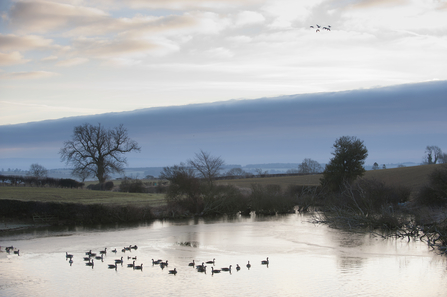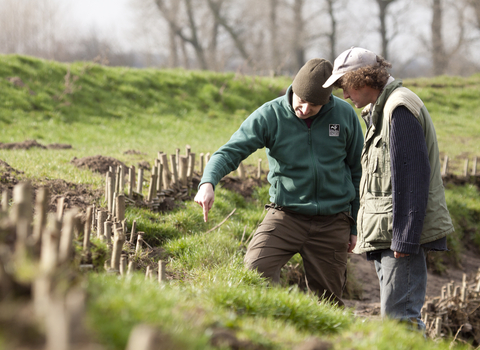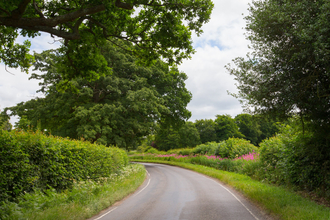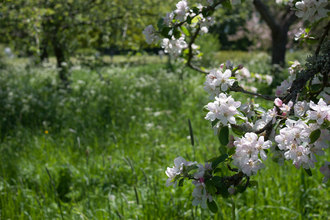What The Wildlife Trusts do
We carry out environmental land management on 100,000 hectares of our land
We give advice to around 5,000 farmers and landowners each year
We work to improve agriculture, land and food policy for wildlife
We manage 26 working farms where we demonstrate wildlife-friendly farming
Farming and wildlife
Over 70% of the UK’s land is farmed in some way – so how this land is managed has a big impact on wildlife. Agriculture policy therefore shapes our countryside. For decades this has often been at the expense of wildlife and natural habitats, and The Wildlife Trusts are working with farmers and governments to change this. The recovery of wildlife in the UK depends on a farming policy which enables farmers to create and restore a thriving natural environment alongside domestic food production.
Farming at the Sweet Spot
Along with the Nature Friendly Farming Network (NFFN) and Nethergill Associates, we've examined how moving to nature-friendly farming can be productive and financially robust for farm businesses across the sector, along with how farming with nature can make you happier, healthier and wealthier.
You can also read our theory and approach in our annex.
Investing in nature friendly farming
Our latest report reveals that UK Government must significantly increase nature-friendly farming budget to meet climate and nature targets. RSPB, National Trust and The Wildlife Trusts call for long-term investment to future proof British farming and support nature recovery. increasing investment in nature-friendly farming to £5.9 billion per annum across the UK is essential to meet the targets and improve the resilience of UK farming. Benefits of nature-friendly farming include less pollution, more climate adaptation, less chemicals, natural pest control and more wildlife, including pollinating insects.
Managing our own land and farms
The Wildlife Trusts manage almost 100,000 hectares of land, and own 26 working farms from lowland arable to upland hill farms which we manage for wildlife. We use these to demonstrate wildlife-friendly farming methods and several are managed in partnership with local farmers.
On our nature reserves we practice sustainable environmental land management using techniques such as conservation grazing. The Wildlife Trusts collectively own more than 7,500 grazing animals, including traditional and rare breed sheep and cattle, native ponies, red deer and even water buffalo. We also use local farmers to help manage wildlife sites. Grazing is the most natural form of management for certain habitats. Livestock can access areas that machinery can’t, and the impacts of grazing are slower than other methods, such as burning or cutting, which means that less-mobile wildlife can thrive.
The Agriculture Act
On 11th November 2020, the Agriculture Act became law. Several years in the making, The Wildlife Trust and many other organisations worked tirelessly to secure the best outcomes for wildlife and the environment. Whilst some successes were secured, there is still much to do.
What it means
One genuine success of the Agriculture Act was the principle of public money paying farmers and land managers to deliver public goods. These are things that society is considered to need, but that are not commodities that can be sold on the marketplace, such as flood alleviation or more wildlife. Over the past years we have been working hard to stop this principle being watered down and to push for greater resources for nature recovery in farming. This is a big change in the way farmers are supported by the state; and can be considered world-leading in its ambition. The Environment Act followed, and we lobbied successfully for this similarly groundbreaking piece of legislation to include ambitious targets for nature protection and recovery.
Another important area is that of standards (from environmental standards to animal welfare standards) – and the related risk associated with lowering these in trade deals with other countries. To ensure these do not slip, we pressed for changes to the Trade and Environment Bills to ensure our UK standards are not undermined by imports to lower environmental standards.
With the Agriculture Act and Environment Acts in place, the real work happens, finalising the programmes, budgets and wider tools, such as advice and education that will deliver the policy. A big part of this, that The Wildlife Trusts have been actively involved in is the development of the Environmental Land Management scheme (ELMs), which will provide the payments to land managers. How much funding is available, what it pays for and what the scale of ambition is, are all crucial details that need getting right before we can measure the true impact of the Act on our environment and natural world. After several years we urgently need ELMS and other nations’ schemes to support all farmers in transition to nature friendly farming.
Read the Wildlife Trusts' latest response to Defra's ELM policies
Safeguarding our standards
We stand together with other environmental NGOs, farming organisations and civil society groups to urge the Government to safeguard our standards and trade regulations. Alongside organisations such as the NFU, National Trust, RSPB, Sustainable Food Trust and Greenpeace, we wrote to the Prime Minister in early 2020, with our concern around the lowering of environmental, animal welfare and safety standards of UK food production when the UK leaves the EU.
Case studies
To assist the development of ELMs, The Wildlife Trusts produced a report with RSPB and National Trust to estimate how much funding environmental land management needs to truly meet the costs.
Yorkshire Wildlife Trust also analysed how ELM could be applied in practice in the River Aire catchment in Yorkshire, to provide a real-life example.
Read the report Read the case study
We also work in coalition with other organisations, for instance through Greener UK - a coalition of charities which formed to work together for wildlife, and Wildlife & Countryside Link.
Finally, you can read our response to Defra’s ELM consultation in July 2020.
Meet some amazing farmers!
Jonathan Boaz

Paul Harris/2020VISION
Jonathan Boaz has been farming since 1968, taking over management of the farm, Mill Farm, Worcestershire in 1992, which now covers an amazing 600 acres. He has witnessed many changes in farming practises over the years, in particular the change in Government’s relatively new support for wildlife-friendly farming. Throughout his extensive career, Jonathan has discovered new, innovative ways to make a profit whilst also leaving room for nature to thrive. He has found ways to use as few chemicals as possible, whilst at the same time maximising soil fertility for crops of wheat. He doesn’t believe that we should rely on chemicals and has been able to reduce his need for them by using homemade compost, choosing crop varieties carefully and making changes to his rotation to manage weed and disease burdens. His logical but creative outlook on farming even saw him win the Arable Innovator Award at the British Farming Awards in 2016 and after 50 years of farming, he is still striving to find the best compromise between growing enough food for an ever-growing population, whilst still working closely with nature.
Jonathan says: “We need to be cautious of preserving our land for future farming generations. Too much intensive farming will only hurt us in the long run. We must find a way to scale back on chemical usage whilst also producing enough food for the ever-growing population.”
Tom Meikle
Tom Meikle is a Trustee of Worcestershire Wildlife Trust, as well as a farmer with a passion for nature and conservation. He’s been farming since 1986 in partnership with his wife and family, who have now owned Wick Grange Farm for three generations. Over the years, the farm has changed a lot. They’ve grown a range of crops, from wheat to barley, as well as rearing a variety of animals including cows and pigs. However, the one thing that’s remained consistent is Tom’s enthusiasm for nature-friendly farming. This interest is what initially attracted him to the Countryside Stewardship Scheme. This scheme worked well from both a business and a conservation perspective, allowing him to put in place several wildlife-friendly farming techniques.
The first thing that Tom implemented was wildflower field margins. These margins were used around every field and, almost overnight, there was a noticeable increase in birds and pollinators. Tom has always strived to look for solutions that solve both farming and conservation problems. One of the best examples of this is his use of old logs. Rather than burning them, which is harmful to the environment, he uses them to make a range of different log piles – a low-cost solution that benefits a whole host of wildlife! Other wildlife-friendly initiatives that Tom implements include building hibernaculum for newts and utilising wild seed mixes to increase the number of insects in order to support bird populations!
The Wildlife Trusts believe that by working together we can change the natural world, for the better
Advising farmers and land managers
We help wildlife to thrive on farms by providing advice and guidance to around 5,000 landowners each year. This often involves helping farmers to access grants and can also involve helping groups of farmers to restore and link habitats at a landscape-scale.
Facilitation Fund
Wildlife Trusts facilitate groups of farmers through the government’s Countryside Stewardship Facilitation Fund. This experience supports the evidence that good quality and trusted advice is essential to achieving and maximising the outcomes of environmental land management. For example farmers and growers in Worcestershire have received funding for a five year Facilitation Fund project to develop habitats and nesting sites for native pollinators. The group are working together to establish viable populations of wild pollinators (bumblebees, solitary bees, hoverflies, butterflies etc). The project, which is coordinated by Worcestershire Wildlife Trust audits land-holdings using a Wild Pollinator Health Check and suggests management changes to complement the farming practises of participants. Lessons learnt and good ideas are shared with the whole group through study days, site visits and training events.
Local Wildlife Sites
There are around 40,000 Local Wildlife Sites in England covering more than 700,000 hectares of land. Two thirds are in private ownership. Local Wildlife Sites provide refuges for a range of wildlife and act as stepping stones to link nationally important ecological areas.
As Local Wildlife Sites are often privately owned, they rely on the commitment of the landowners, farmers and volunteers who are prepared to carry out sensitive habitat management. Wildlife Trust advisors work with landowners and farmers responsible for Local Wildlife Sites to help them do this. Without such care and effort, a site will gradually decline and lose its diversity and abundance of species. The Wildlife Trusts latest survey (2018) revealed that of more than 6,500 local wildlife sites surveyed, 16% had been damaged or lost over five years, the majority of which relates to poor maintenance.
Water Quality
Wildlife Trusts across England are working with water companies to help improve water quality which is impacted by farming. For example, Severn Trent Water employs Wildlife Trust farm advisors across the Severn and Trent river catchments to advise farmers on how to reduce their use of metaldehyde. This is the powerful ingredient in slug pellets which is extremely difficult and expensive for water companies to treat as well as harming wildlife.







